Proximity Access Control Market Size
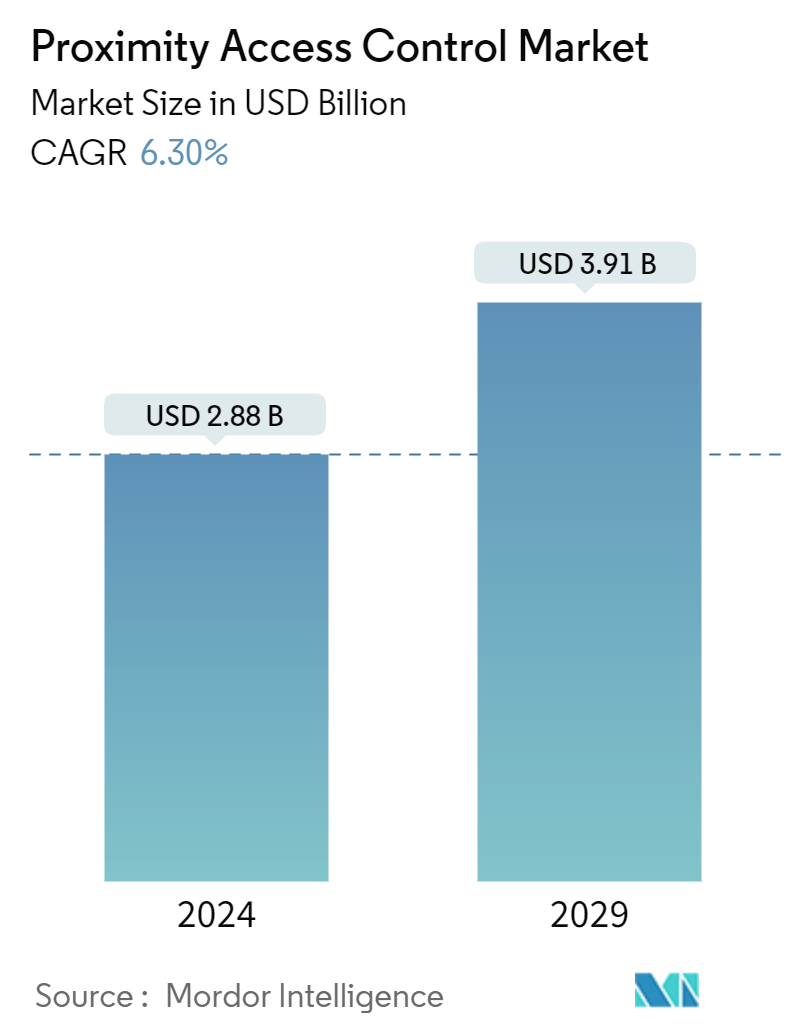
| Study Period | 2019 - 2029 |
| Market Size (2024) | USD 2.88 Billion |
| Market Size (2029) | USD 3.91 Billion |
| CAGR (2024 - 2029) | 6.30 % |
| Fastest Growing Market | Asia Pacific |
| Largest Market | North America |
| Market Concentration | Low |
Major Players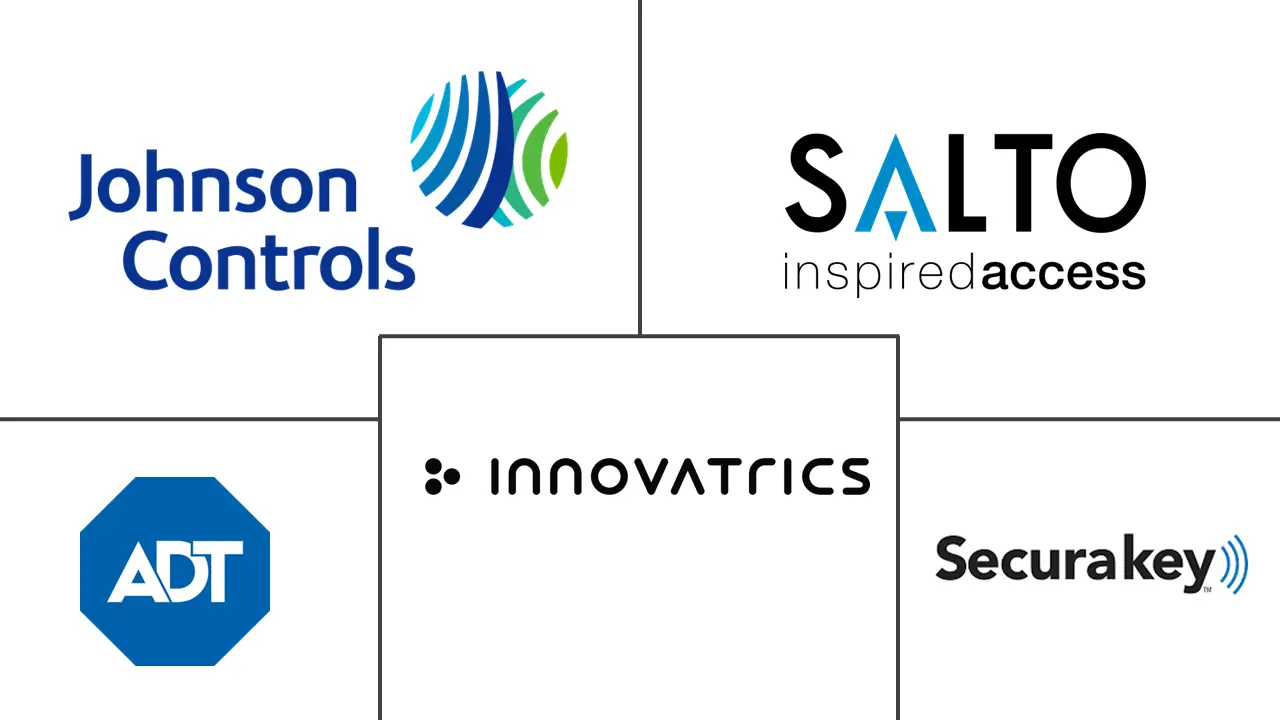
*Disclaimer: Major Players sorted in no particular order |
Proximity Access Control Market Analysis
The Proximity Access Control Market size is estimated at USD 2.88 billion in 2024, and is expected to reach USD 3.91 billion by 2029, growing at a CAGR of 6.30% during the forecast period (2024-2029).
• Proximity access control systems eliminated the requirement of physical keys, allowing for smooth entry into buildings or areas. Additionally, these systems provide enhanced security through encrypted communication and the ability to revoke access in case of a lost or stolen card. The increasing adoption of cloud access control systems offers high potential. These cloud-based systems provide scalability, adaptability, and remote management, enabling enterprises to manage access across multiple locations more easily. The widespread fingerprint recognition technology drives the growth of the proximity access control market.
• The use of proximity access control systems provides a high level of security compared to conventional methods, thus decreasing the likelihood of unauthorized access and security breaches. There is a rising demand for access control systems to be integrated with cutting-edge technologies such as AI and Machine Learning (ML).
• Access control systems can identify anomalies, analyze trends, and improve overall security by continuously learning and responding to new threats using AI and ML algorithms. Utilizing biometrics in access technologies will open up new possibilities for using only fingerprints or facial features. Utilizing biometric identifiers as an additional authentication factor (for example, biometric scans for physical identity verification) can assist organizations in eliminating unauthorized access and fraudulent algorithms.
• For instance, in March 2023, Vertiv announced the introduction of its Vertiv Intelligent Fingertrack Access Control System ((iFACS), a next-generation Data Center access control solution for rack enclosures in India. This IP-based Access Control Solution is intended to physically protect the racks containing mission-critical machinery, resources, and enterprise-level data. Vertiv's Intelligent Fingerspace Access Control System is a lock controller designed to protect the front and rear doors of Rack Enclosures. It has been developed with the most up-to-date biometrics and identity authentication technologies.
• The adoption of digital wallets is surging the rate of mobile ID adoption while also broadening the scope of use cases beyond payment transactions to include employee identification cards, driver's licenses, national identification cards, and passports.
• Major players such as Google, Apple, and Amazon are introducing digital wallets that are becoming increasingly popular. The capabilities of these wallets are expanding to include the ability to add keys, employee identification cards, student identification cards, and more directly to the wallet application. A prime example is Silverstein Properties in New York City, which provides employees with Apple Wallet access to secure contactless entry to their office buildings.
• The collection of access data has raised several privacy and data protection concerns, particularly in regions with stringent privacy regulations, thus impeding market development. Furthermore, macroeconomic factors such as government regulations on the import and export of the electronics market and the disruption in global supply chain operation have affected the market growth.
• Furthermore, integrating proximity access control systems into the existing infrastructure may be laborious and costly, thus discouraging the adoption. In addition, in some regions, companies may need to be aware of the advantages associated with proximity access control, resulting in a shortage of demand.
Proximity Access Control Market Trends
Biometric Scanners to Hold Significant Market Share
• Biometric scanners, such as facial, fingerprint, and iris recognition, offer a high degree of security due to their reliance on distinct psychological or behavioral traits that are difficult to imitate or falsify. Godrej Security Solutions is expected to significantly impact the upcoming Central Vista Avenue in India in August 2023, with estimates suggesting that the security measures for the project could cost up to INR 100 crore (USD 12.0 million). The company has provided locks and digital security solutions for various historical landmarks, including the Taj Mahal (Taj Mahal Locks and Locks), financial institutions such as Punjab National Bank, State Bank of India, and Muthoot.
• Biometric scanners enhance visitor verification, guaranteeing that only authorized personnel can enter restricted areas. As more organizations become aware of biometric identification and access controls, security professionals educating them will benefit from the advantages. The commercial adoption of biometric identifiers in access controls and identification is currently at a critical juncture. Major corporations, airlines, retailers, government departments, and law enforcement agencies are all utilizing some biometric technology, increasing recognition of the potential benefits to end users in terms of operational efficiency, increased security, and cost savings.
• The implementation of contactless solutions has become increasingly important as biometric smart locks offer a touchless approach to entry, which is in line with health and safety regulations. In addition, several biometric smart locks are available for remote control via mobile applications, allowing users to authorize access to guests or service providers without being physically present.
• The biometric smart locks enable users to access the properties by utilizing the physiological characteristics, thus ensuring that only authorized individuals can open the door. Smart door locks have become increasingly in demand in the United States. While most residential door locks in the United States are mechanical, an increasing proportion of exterior locks are now replaced by smart door locks as connectivity becomes critical in staying competitive. As a result, value creation is shifting to new features and applications.
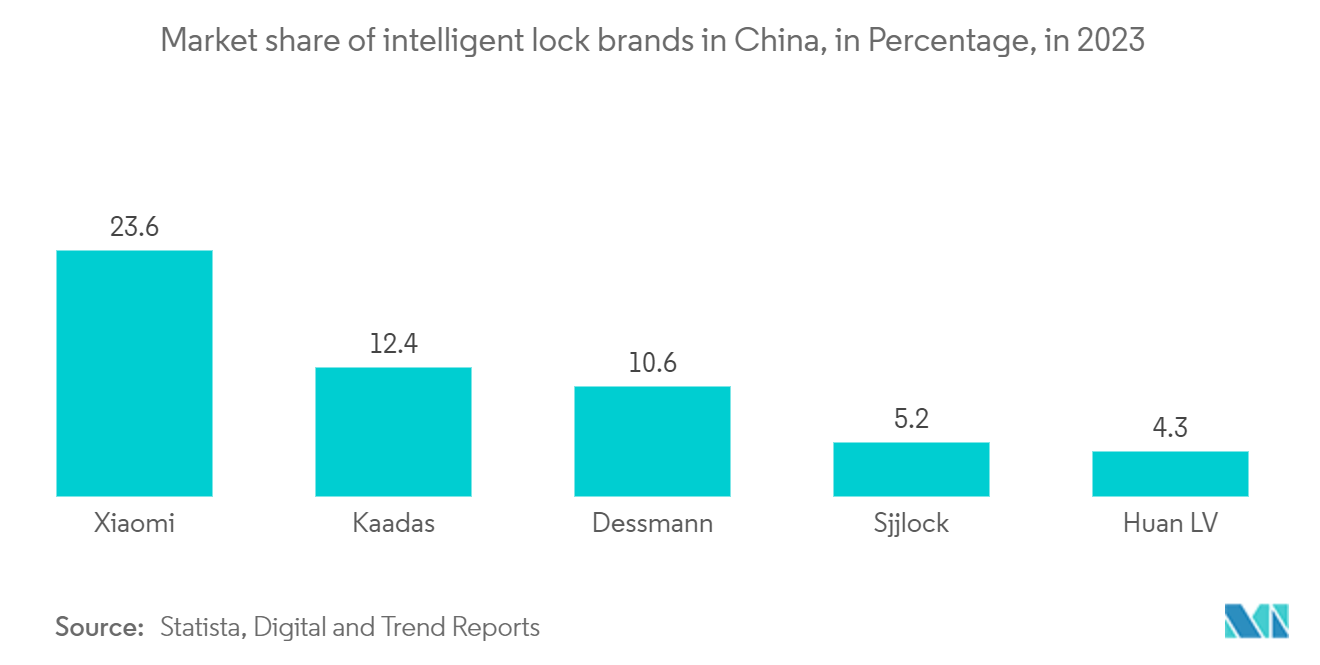
Asia-Pacific to Witness Significant Growth
• Access control systems protect against the infiltration of confidential information, fraud, and theft by guaranteeing that only authorized personnel can access specified areas. The emergence of the Internet of Things has led to the proliferation of intelligent systems, such as access control, in the context of connected devices and environments.
• For instance, in May 2023, Nidec Instruments announced the development of a multi-purpose card reader. This new product is primarily intended for slot machines and payment terminals in amusement facilities in both domestic and foreign countries. This card reader can process magnetic data, utilize NFC and Bluetooth technology for communication, and read QR codes.
• Access control systems like digital locks in South Korea are witnessing a surge in growth due to various factors. The country's high penetration rate of the internet and its technologically savvy population have contributed to the development of digital locks. With the ease of use of smartphones and the advent of widespread internet access, digital locks can be accessed and controlled remotely, which aligns with the convenience and adaptability customers desire. Rapid technological progress, such as biometric identification, wireless integration, and enhanced battery life, has enabled digital locks to become more efficient and effective, thus stimulating consumer demand and adoption.
• The retail landscape has been significantly altered by the development of contactless payment technology, driven by technological advancements and changing consumer preferences. The widespread use of mobile phones and the accessibility of Internet services have contributed to the growth of digital payments.
• Contactless technology offers a rapid and efficient payment option, becoming increasingly common in today's rapidly changing world. For instance, in January 2023, the Delhi government introduced smart mobility cards, allowing commuters to electronically pay their fare on the city's DTC buses as part of the NCMC. Passengers from all over India can now use their RuPay debit cards compliant with the NCMC for a smooth journey.
• The attention to the need for solid access control systems has been heightened in the wake of significant data breaches and incidents. Following a data breach, attackers may gain access to confidential information about an individual's access credentials or authentication techniques. These measures can result in unauthorized access to secure areas, thus compromising physical security.
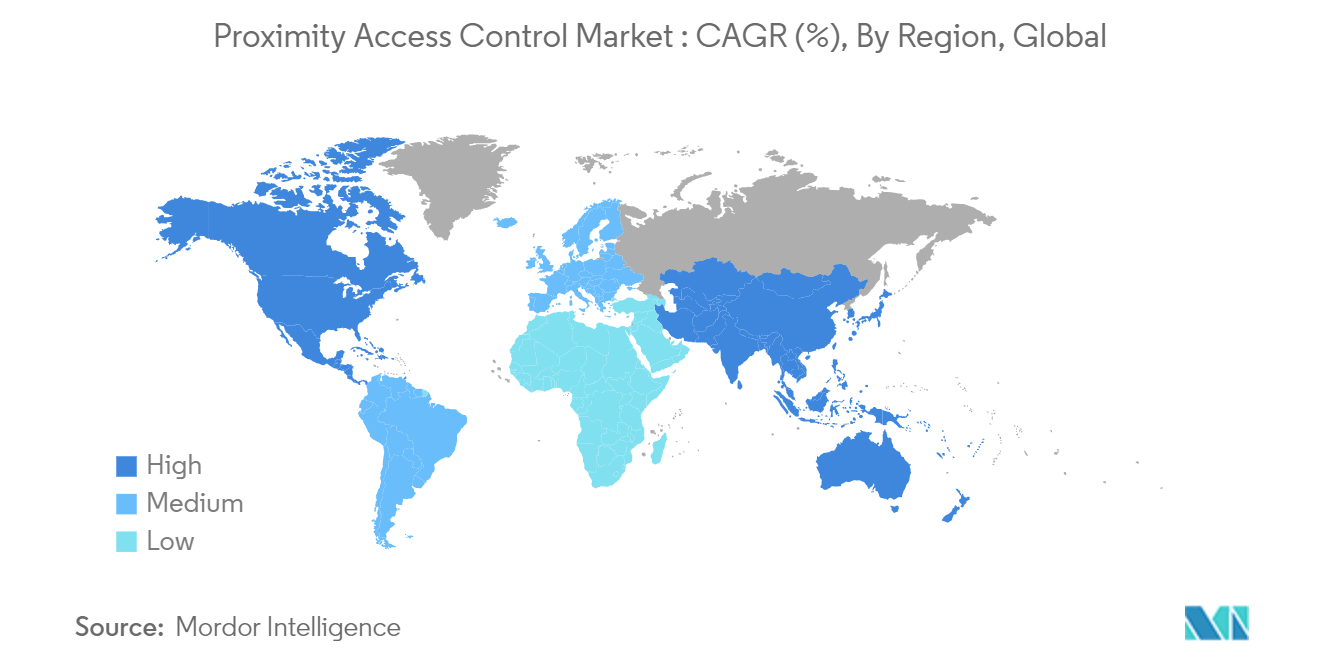
Proximity Access Control Industry Overview
The proximity access control market is fragmented and consists of several players. The companies in the market are continuously trying to increase their market presence by expanding their operations, introducing new products, forming strategic partnerships, mergers and acquisitions, and collaborations. Some of the major players include Johnson Controls, SALTO Systems, ADT, Innovatrics, Securakey, and many more.
• In April 2024, Acre Security announced the introduction of acre Access Control in conjunction with the acre Smart Controller and the acre Reader. The integrated ecosystem provides a wide range of flexibility and presents the quickest and most intuitive path to embracing cloud technology. Collectively, these solutions furnish a straightforward and resilient security resolution to cater to the changing requirements of any establishment.
• In March 2024, Allegion US announced the introduction of the Schlage XE360 Series Wireless Locks, an electronic lock collection tailored to meet the demands of the multifamily market. This new series represents the latest advancement in electronic lock technology by Schlage, offering a variety of sought-after options and features specifically catered to multifamily properties. The locks are designed to seamlessly integrate into a wide range of common area openings, ensuring versatility and convenience for property managers and residents alike.
Proximity Access Control Market Leaders
-
SALTO Systems
-
Innovatrics
-
Securakey
-
ADT Inc.
-
Johnson Controls International PLC
*Disclaimer: Major Players sorted in no particular order
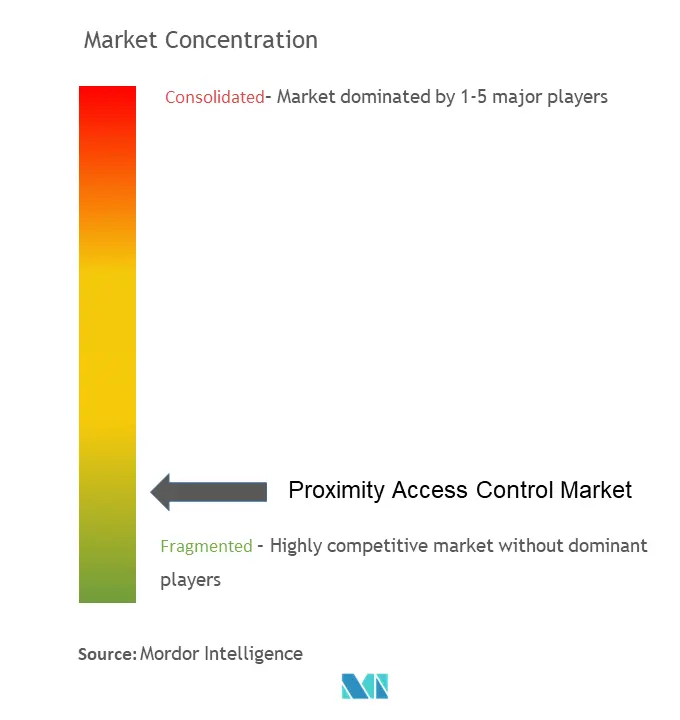
Proximity Access Control Market News
- In January 2024, Integrated Biometrics (IB) revealed that its slim Danno FAP 30 biometric capture device has been incorporated into DataWorks Plus' latest Evolution 3 handheld device. DataWorks Plus offers various solutions tailored for law enforcement, criminal justice, and government agencies, such as Livescan identity management software and multimodal biometric technology for identification and verification.
- In November 2023, IDSecurityOnline.com expanded its range of access cards by introducing a brand-new collection of high-quality proximity cards. This latest addition boasts a remarkably sleek card surface and the added feature of personalization with black text.
Proximity Access Control Market Report - Table of Contents
1. INTRODUCTION
1.1 Study Assumptions and Market Definition
1.2 Scope of the Study
2. RESEARCH METHODOLOGY
3. EXECUTIVE SUMMARY
4. MARKET INSIGHTS
4.1 Market Overview
4.2 Industry Attractiveness - Porter's Five Forces Analysis
4.2.1 Bargaining Power of Suppliers
4.2.2 Bargaining Power of Consumers
4.2.3 Threat of New Entrants
4.2.4 Threat of Substitutes
4.2.5 Intensity of Competitive Rivalry
4.3 Impact of COVID-19 Aftereffects and Other Macroeconomic Factors on the Market
5. MARKET DYNAMICS
5.1 Market Drivers
5.1.1 Continuous Advancements in Technology, such as Authentication Methods, Improved Sensors
5.1.2 Increasing Investments in Smart Infrastructure, Smart Cities
5.1.3 Integration of Biometric Authentication Methods such as Fingerprint, Facial Recognition
5.2 Market Challenges
5.2.1 High Implementation and Maintenance Cost
5.2.2 Increasing Concerns about Privacy and Data Protection
5.2.3 Rising Concerns about Credential Theft
6. MARKET SEGMENTATION
6.1 By Solution
6.1.1 Hardware
6.1.2 Software
6.2 By Type
6.2.1 Card Readers
6.2.2 Biometric Scanners
6.2.3 Proximity Readers
6.2.4 Alarms
6.2.5 Metal Detectors
6.2.6 Door Controllers
6.2.7 Wireless Locks
6.3 By End-user Industry
6.3.1 Government Services
6.3.2 Banking and Financial Services
6.3.3 IT and Telecommunications
6.3.4 Transportation and Logistics
6.3.5 Retail
6.3.6 Healthcare
6.3.7 Residential
6.3.8 Others
6.4 By Geography ***
6.4.1 North America
6.4.1.1 United States
6.4.1.2 Canada
6.4.2 Europe
6.4.2.1 United Kingdom
6.4.2.2 Germany
6.4.2.3 France
6.4.3 Asia
6.4.3.1 China
6.4.3.2 Japan
6.4.3.3 India
6.4.4 Australia and New Zealand
6.4.5 Latin America
6.4.6 Middle East and Africa
7. COMPETITIVE LANDSCAPE
7.1 Company Profiles*
7.1.1 Johnson Controls
7.1.2 SALTO Systems
7.1.3 ADT
7.1.4 Innovatrics
7.1.5 Securakey
7.1.6 HID Global
7.1.7 Genetec
7.1.8 Idemia
7.1.9 Honeywell International inc
7.1.10 Vicon
7.1.11 M2SYS Technologies
7.1.12 Schneider Electric
7.1.13 Spectra Technovision Pvt. Ltd
7.1.14 i2 Security Solutions
7.1.15 FaceKey
8. INVESTMENT ANALYSIS
9. FUTURE OF THE MARKET
Proximity Access Control Industry Segmentation
The study tracks the revenue accrued through the sale of proximity access control software and hardware by various players in the global market. The study also tracks the key market parameters, underlying growth influencers, and major vendors operating in the industry, which supports the market estimations and growth rates over the forecast period. The study further analyses the overall impact of COVID-19 aftereffects and other macroeconomic factors on the market. The report’s scope encompasses market sizing and forecasts for the various market segments.
The proximity access control market is segmented by solution (Hardware and Software), by type (card readers, biometric scanners, proximity readers, alarms, metal detectors, door controllers, and wireless locks), by end-user industry (government services, banking and financial services, IT and telecommunications, transportation and logistics, retail, healthcare, residential, and others), and by geography (North America, Europe, Asia Pacific, and Rest of the World). The report offers market forecasts and size in value (USD) for all the above segments.
| By Solution | |
| Hardware | |
| Software |
| By Type | |
| Card Readers | |
| Biometric Scanners | |
| Proximity Readers | |
| Alarms | |
| Metal Detectors | |
| Door Controllers | |
| Wireless Locks |
| By End-user Industry | |
| Government Services | |
| Banking and Financial Services | |
| IT and Telecommunications | |
| Transportation and Logistics | |
| Retail | |
| Healthcare | |
| Residential | |
| Others |
| By Geography *** | |||||
| |||||
| |||||
| |||||
| Australia and New Zealand | |||||
| Latin America | |||||
| Middle East and Africa |
Proximity Access Control Market Research FAQs
How big is the Proximity Access Control Market?
The Proximity Access Control Market size is expected to reach USD 2.88 billion in 2024 and grow at a CAGR of 6.30% to reach USD 3.91 billion by 2029.
What is the current Proximity Access Control Market size?
In 2024, the Proximity Access Control Market size is expected to reach USD 2.88 billion.
Who are the key players in Proximity Access Control Market?
SALTO Systems, Innovatrics, Securakey, ADT Inc. and Johnson Controls International PLC are the major companies operating in the Proximity Access Control Market.
Which is the fastest growing region in Proximity Access Control Market?
Asia Pacific is estimated to grow at the highest CAGR over the forecast period (2024-2029).
Which region has the biggest share in Proximity Access Control Market?
In 2024, the North America accounts for the largest market share in Proximity Access Control Market.
What years does this Proximity Access Control Market cover, and what was the market size in 2023?
In 2023, the Proximity Access Control Market size was estimated at USD 2.70 billion. The report covers the Proximity Access Control Market historical market size for years: 2019, 2020, 2021, 2022 and 2023. The report also forecasts the Proximity Access Control Market size for years: 2024, 2025, 2026, 2027, 2028 and 2029.
Proximity Access Control Industry Report
Statistics for the 2024 Proximity Access Control market share, size and revenue growth rate, created by Mordor Intelligence™ Industry Reports. Proximity Access Control analysis includes a market forecast outlook for 2024 to 2029 and historical overview. Get a sample of this industry analysis as a free report PDF download.



